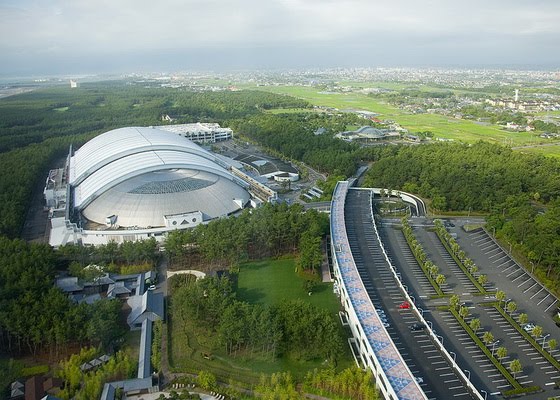 Cowboys Stadium is a domed stadium with a retractable roof in Arlington, Texas. It serves as the home of the National Football League's Dallas Cowboys. It replaced the partially-covered Texas Stadium, which opened in 1971, as the Cowboys' home. It was completed on May 27, 2009. The stadium seats 80,000, making it the 3rd largest seating capacity stadium in the NFL.
Cowboys Stadium is a domed stadium with a retractable roof in Arlington, Texas. It serves as the home of the National Football League's Dallas Cowboys. It replaced the partially-covered Texas Stadium, which opened in 1971, as the Cowboys' home. It was completed on May 27, 2009. The stadium seats 80,000, making it the 3rd largest seating capacity stadium in the NFL.The stadium is the largest domed stadium in the world, has the world's largest column-free interior and the largest high definition video screen which hangs from 20 yard line to 20 yard line. The facility can also be used for a variety of other activities outside of its main purpose (professional football) such as concerts, religious ceremonies, basketball games, college football and high school football contests, soccer matches, Motorcross races and rodeos similar to the Houston Livestock Show and Rodeo.
Video screen
A highlight of Cowboys Stadium is its gigantic center-hung high-definition television screen, the largest in the world, sometimes referred to as "Jerry-Tron". The 160-by-72-foot (49 by 22 m), 11,520-square-foot (1,070 m2) scoreboard surpasses the 8,736 sq ft (812 m2) screen that opened in 2009 at the renovated Kauffman Stadium in Kansas City, Missouri as the world's largest.
 The screens were developed by Mitsubishi's Diamond Vision Systems. Each center-hung sideline display consists of 10,584,064 LEDs, consuming some 635,000 watts. Because each pixel consists of four LEDs (2 red, 1 green, 1 blue), the 2,176 X 4,864 LED distribution corresponds to a 1,088 X 2,432 pixel resolution, the equivalent of 1080p. However the image can actually be considerably sharper than the resolution suggests, because Diamond Vision's "Dynamic Pixel" technology allows the corner LEDs of four neighboring pixel clusters to function as a pixel cluster together, providing virtual pixels between each physical pixel.
The screens were developed by Mitsubishi's Diamond Vision Systems. Each center-hung sideline display consists of 10,584,064 LEDs, consuming some 635,000 watts. Because each pixel consists of four LEDs (2 red, 1 green, 1 blue), the 2,176 X 4,864 LED distribution corresponds to a 1,088 X 2,432 pixel resolution, the equivalent of 1080p. However the image can actually be considerably sharper than the resolution suggests, because Diamond Vision's "Dynamic Pixel" technology allows the corner LEDs of four neighboring pixel clusters to function as a pixel cluster together, providing virtual pixels between each physical pixel.During the debut preseason game of Cowboys Stadium, a punt by Tennessee Titans punter A. J. Trapasso hit the 2,100 in. screen above the field. The punt deflected backwards and was ruled in-play until Titans coach Jeff Fisher informed the officials that the punt struck the scoreboard. By rule, the down was replayed. Cowboys owner Jerry Jones believes that Trapasso was trying to hit the scoreboard, saying "If you look at how you punt the football, unless you're trying to hit the scoreboard, you punt the ball to get downfield. You certainly want to get some hangtime, but you punt the ball to get downfield, and you sure don't punt the ball down the middle. You punt it off to the side." Whether the screen would affect an opposing teams punting strategy has been debated. For teams with strategies centered on maximizing hang-time, physicist Christopher Moore of Longwood University has shown via computer simulation that well-kicked punts have the potential to hit the screen no matter the field position. Trapasso disputed Jones' suggestion that he was intentionally trying to hit the board, and other NFL punters have suggested that the board may pose a problem for longer hang-time punts.
Guinness World Records was on hand at the September 28, 2009 game against the Carolina Panthers to award certificates to the Chairman of Mitsubishi Electric and Dallas Cowboys owner Jerry Jones for the World's Largest High-Definition Video Display.





























































